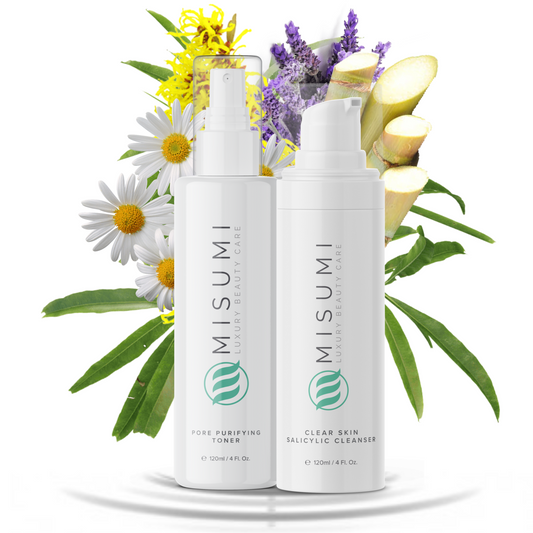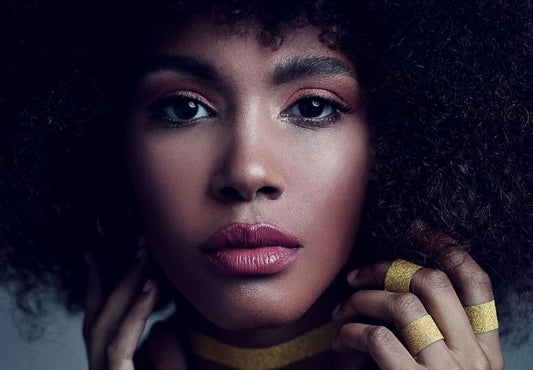The best part of facials, or any skin treatment for that matter, is usually the massage that goes with it.
Whether we opt for anti-aging, rejuvenating, anti-acne, or simple vitamin-packed facials for nourishing the skin, the massage is benefiting our psychological well-being more than anything. And there’s a reason for this - it’s because the face is full of nerves and pleasure points. So, you shouldn’t be surprised that a face massage is one of the most popular options for improving the overall appearance of your skin.
But do you know the benefits of having a facial massage?
The soothing sensations you get from a good face massage are just the cherry on top. Most dermatologists agree that this method brings a variety of skin benefits, and we’re here to cover all of them.
We’ll also tell you how exactly a face massage works, its downsides, and how to do it at home, too! So after you've completed your skincare routine (check out Misumi's Complete Clear 3-Step System) you can relax your face even more with a message.
We’ll leave you with one of the best facial massage techniques and routines to relieve muscle tension and achieve all those anti-aging and glowing skin benefits.
Facial Massages: Purpose & Classification

The origin of face massages can be found in ancient times. People of all cultures used this method for pain relief, healing, and cosmetic improvement purposes.
Today, facial massages are very popular Western and Eastern beauty treatments. They're mostly advertised to slow down the aging process and help you achieve a younger-looking and glowing complexion, but they're also a wonderful way to relax. Other common uses include reducing stress levels, improving your mental health, headaches, premenstrual syndrome (PMS), sinus congestion, and boosting circulation. They also help you absorb skincare products better, too!
They're usually done by a professional therapist, an esthetician, or by yourself at home. They can be part of a whole-body massage or part of a facial treatment.
Additionally, you can massage your face using your hands, or with face massagers from almost any cosmetic store or supermarket.

When it comes to skincare products, the product you’ll use will more or less dictate the purpose of the facial massage. For example, using highly-concentrated moisturizing oils can soothe and regenerate dry and flaky skin. On the other hand, using more specialized products, like AHA-based creams, can deeply cleanse the skin and prevent further breakouts.
In Eastern therapies, a facial massage is part of a full-body treatment in which pressure points on the face and neck are stimulated in order to release blockages in the blood flow, helping to relax the face muscles.
The Benefits of Facial Massage
We already know what the cosmetic studios and facial massage machine sellers say about the uses and benefits of facial massage. But, what does science say? Is there any truth to the claims?
Well, one study from 2007, published in the journal of Complementary Therapies in Clinical Practice investigated the effects of foot and facial massages on sleep induction, blood pressure, pulse, and respiratory rate. The results showed that a good massage is an effective method for lowering blood pressure, increasing sleep quality, and decreasing the respiratory rate.
Here’s how this helps the skin.

Reduced Stress Levels
The relationship between stress and poor skin complexion is quite well documented. Stress affects our body negatively, increasing free radicals and stress hormones, which can damage the cells in our internal organs and the skin’s tissue. If you want more detail, we have you covered with our article on acne and stress. Stress plays a key role not only in acne development but in many other common skin disorders.
As we saw from the above-mentioned article, facial massages are effective in lowering blood pressure, and respiratory rate, and increasing the quality of sleep, all of which help decrease stress levels.
Another study from 2008, published in Biomedical Research, concluded that facial massages might reduce psychological distress and activate the sympathetic nervous system.
We can very well understand how this method is one of the most popular tricks to quickly relax after a stressful day, keeping our mind and skin healthy.

Healthy and Glowing Skin
When we massage our face, we tackle the lymphatic system, stimulating lymphatic drainage, which facilitates toxin elimination. Lymphs play a crucial part in our health since the liquid secreted from lymph nodes removes toxins and protects our body. Moving tight muscles helps stimulate the lymph fluid to circulate our face. This will result in brighter and healthier-looking skin.
Additionally, if we know how to massage our face, we can really hit the spots that carry all the tension and release it. The relaxation of the muscles will give you fresh, well-rested, and youthful-looking skin. You can also expect to see dewy, glowing skin in the mirror.

Tightening the Facial Muscles
Facial massages can help you tighten the muscles on your face, reversing sagging and loose skin, a common aging sign. In 2002, a study published in the International Journal Of Dermatology tried to answer the question of whether a rejuvenating facial massage is a bane or boon.
The study questioned over 140 women on the various aspects, benefits, and side effects, and learned that around 50% of the subjects felt that their skin was tighter after the massage.
We should note that, although face massages are a great way to increase blood flow and tighten the skin even further, exercising regularly and maintaining a healthy lifestyle is far more effective.
However, if you have a busy schedule we recommend reading our article on “How To Tighten The Skin Naturally” to learn some quick tips and tricks.
Anti-Aging Benefits
Sagging or loose skin is one of the symptoms of aging, which we now know facial massages can help with. But more than that, it can relax the muscles that cause stress lines. By stimulating and increasing circulation, we help our skin produce collagen and elastin.
(And, we all know how collagen works, right? If not, check our article about collagen in skincare and find out all the benefits that make it so popular.)
When it comes to aging skin, maintaining collagen levels plays a key role in the appearance of fine lines, wrinkles, and age spots. Collagen is the building block of the skin’s tissue that is produced during the skin healing process. This process prevents imperfections from manifesting on the skin's surface.
Caring for the skin and massaging it regularly might help prolong the aging process, and maintain a youthful appearance much longer.

Reducing Facial Puffiness
Stress, dehydrated skin, alcohol, smoking, lack of sleep, and many other factors can make us retain fluid and make our skin puffy. Luckily, massaging your face can take care of all those problems.
We mentioned that facial massages stimulate lymphatic drainage, which reduces swelling and inflammation. A face massage also increases blood circulation and oxygen flow to the muscles and skin. The massage can help drain fluid retention and reduce puffiness.
How Does Facial Massage Work?

Ultimately there are two goals for most facial massages.
First, a high-quality treatment aims to relax nerve tension, and second, it can drain excess fluid from your facial skin. For this, the target is the lymph nodes underneath the ears and on the neck. With specific movements, a facial massage increases circulation and blood flow to the area. This means more oxygen and more nutrients. Bringing more vitamins and minerals to the surface of our face can kick-start collagen production in the facial tissue, helping the skin heal better and protect itself from daily damage.
You'll feel your facial muscles relax, and your skin tightens, and you'll end up with an overall more fresh and glowing complexion. Your cheekbones should take on a warm, healthy blush due to increased blood circulation.
What Are the Downsides?

Surprisingly, even though it looks like a really gentle and non-invasive approach, the facial massage treatment has its downsides.
For example, this article found that sixty‐one (36.1%) patients developed erythema and puffiness within 15 minutes to 2 hours after undergoing a facial treatment that lasted 2 to 6 hours.
Eight (4.7%) women developed mild dermatitis on the face, while 47 (33.1%) of the participants, developed acneiform eruptions after a facial massage treatment with creams containing exotic ingredients, such as gold salts.
The results from the study led the authors to conclude that although there are several benefits of a facial massage treatment, there may be immediate side effects, such as erythema and edema, as well as delayed problems, such as dermatitis and acneiform eruption, typically in about one‐third of the clients.
To make things clearer (and not scare you away), this study is simply showing us the importance of the foundation cream we use for our face massage and the pressure we apply - especially if we use a skin massaging device.

We can tighten the facial muscles, fade superficial wrinkles, and reduce puffiness, or we can easily irritate the face, cause infection, and worsen the symptoms of a certain skin condition.
Always do a patch test for the face oil, lotion, or cream you’re planning on using. Or, even better - use a product that you know works well for your skin type. Everyone's skin structure is different.
Another problem with massage, as with other beauty treatments, is the condition of your face. If you’re experiencing acute acne lesions which are inflamed or infected, you shouldn’t apply anything or touch your skin in any way. In this case, always consult with your healthcare provider or a board-certified dermatologist before undergoing any treatment.
Facial Massage Movements: How to Do it at Home

There are so many different techniques you can try to relax your face muscles. If you decide to try a facial at home, follow these massage techniques to see optimal results.
- Before you start, wash your hands with soap and clean water. Cleanse your face, and pat it dry. Dirt or bacteria on your hands or your face can cause acne breakouts, infections, rashes, and other complications.
- If you or the person receiving the massage are wearing contact lenses, remove them before you start. Otherwise, you might hurt your eyes or irritate them.
- Find the right spot. The best position is when you’re lying down on a flat surface or sitting on a chair with your head rested. Unfortunately, if you’re giving yourself a massage, you’ll probably be standing and facing a mirror. In any case, be careful of the position of your head, so that you don’t cause too much tension in the neck.
- The next step is to gently apply the foundation cream or lotion to your face, avoiding the mouth and outer corner, and inner corner of the eyes. Start massaging the face and neck areas in small symmetrical circles. You can use your middle fingers, ring fingers, or pinky fingers - whatever makes you feel most comfortable. Make movements up the neck toward the head, from the center of the face toward the ears, and from the nose toward the forehead, following the natural curves and muscles of your face. You shouldn’t apply too much pressure. Light strokes are more than enough.
- Most facial massages often start with movement on the forehead. Place your fingertips on the brow bone and move them up and around in circular motions. Make sure to apply gentle pressure - be constant but not firm. You should move from the center toward the temples. This relieves tension in the head and soothes tension headaches.
- Next, massage the temples. Place one hand on each side of your temples. Using only your fingertips, massage lightly in circles, applying gentle pressure on both sides.
- Moving downward, massage the cheekbones. Follow your bone structure and move your hands underneath the cheekbones on each side and gently rub toward the ears.
- Continue to massage the jaw and your lower cheeks. Move your whole hands in upward and outward movements, so that they slide along the cheeks towards the ears.
- Repeat all movements several times, for a few minutes, before you move on to the next area.
- Once you've finished, remove the massage cream or lotion with fresh and damp cotton pads. Most facials end with a special skincare product applied to the face, but you can use a moisturizer or a serum.
Face Massage Machine: is it Worth it?

A lot of bloggers and beauty experts swear by it. Most cosmetic studios use professional facial massage devices for their treatments - from simple face rollers to more complicated devices. But, the question remains - are they better than the traditional hand-approach massage? And, can they be more dangerous?
Some people argue that by using a facial massager, you avoid rubbing or pulling the skin; you’re getting a more gentle and thoughtful technique to get optimal results. It’s believed that the devices are clean, easy on the skin, and super effective. Plus, they’re a lot more sophisticated, which brings additional benefits.
For example, there are devices with LED lights that claim to remove dirt and bacteria from the face. Some massage devices come with special gel washes that target signs of aging, like sagging, dullness, and wrinkles.
Overall, facial massage devices are praised for being a more sanitary option. They’re practical and easy to use.
However, better quality comes at a higher price, which can be a problem. You'll want to invest in high-quality jade rollers or similar devices. And, of course, not following the instructions and using the device incorrectly can lead to complications and even adverse reactions..

Best Step-by-Step Facial Massage Routine
Here's one incredible facial massage technique, you can implement in your daily skincare regimen. Originating in Korea, the following massage is said to be the ultimate anti-aging trick. You don't need any fancy devices, such as a facial massage roller.
Start your daily skincare routine as you would normally do. Cleanse your face, apply a toner, then go directly to your massage cream. When you've finished with the massage, wipe off the cream residue, cleanse and tone your face again. Then, continue with the rest of your skincare routine.
Before you start, choose your favorite carrier oil, or cream for the massage. One safe and very beneficial option is argan oil, but you can check out our article about carrier oils linked above and pick your favorite.
The Movements:
Start with the V-line, from your chin to your ears. You’ll feel a node right behind your ear, by your jaw. The goal is to lightly massage it in a circular motion. Be careful not to place too much pressure. These movements are for lymphatic drainage, which will improve the shape of your face and prevent sagging skin.
Next, make a claw with your knuckles, and move from your chin toward your ears, following the jawline. Here, you can use more pressure. Brush your fingers down your neck and finish off with a sweeping motion across your collarbone.








